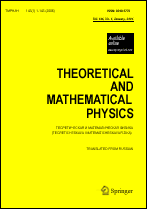|
This article is cited in 7 scientific papers (total in 7 papers)
Anomaly Problem in the $N=1$ Supersymmetric Electrodynamics as a Consequence of the Inconsistency of the Dimensional Reduction Method
K. V. Stepanyantz
M. V. Lomonosov Moscow State University
Abstract:
We compare the calculation of the two-loop $\beta$-function in the $N=1$ supersymmetric electrodynamics regularized via higher derivatives and via dimensional reduction. We show that the renormalized effective action is the same for both regularizations. But in the method of higher derivatives, unlike in the dimensional reduction, the $\beta$-function defined as the derivative of the renormalized coupling constant with respect $\ln\mu$ turns out to be purely one-loop. The anomaly problem therefore does not occur in this regularization, because in the method of higher derivatives, the diagrams with counterterm insertions make a nonzero contribution, which is evaluated exactly in all orders of the perturbation theory. When dimensional reduction is used, this contribution is zero. We argue that this result is a consequence of the mathematical inconsistency of the dimensional reduction method and that just this inconsistency leads to the anomaly problem.
Keywords:
supersymmetry, regularization, higher covariant derivatives, dimensional reduction.
Received: 30.01.2003
Revised: 06.06.2003
Citation:
K. V. Stepanyantz, “Anomaly Problem in the $N=1$ Supersymmetric Electrodynamics as a Consequence of the Inconsistency of the Dimensional Reduction Method”, TMF, 140:1 (2004), 53–77; Theoret. and Math. Phys., 140:1 (2004), 939–957
Linking options:
https://www.mathnet.ru/eng/tmf83https://doi.org/10.4213/tmf83 https://www.mathnet.ru/eng/tmf/v140/i1/p53
|


| Statistics & downloads: |
| Abstract page: | 423 | | Full-text PDF : | 216 | | References: | 99 | | First page: | 1 |
|




 Contact us:
Contact us: Terms of Use
Terms of Use
 Registration to the website
Registration to the website Logotypes
Logotypes








 Citation in format
Citation in format 
